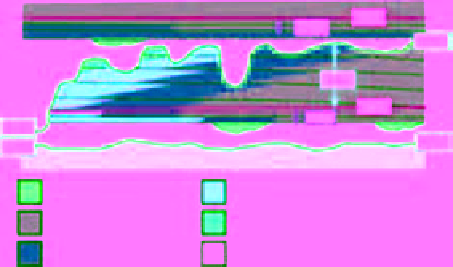Geoscience Reference
In-Depth Information
fields, for example, have a considerable thick-
ness (up to 400 m) and many marine flooding
events deposited intervals of offshore claystones.
However, the latter are poorly constrained
biostratigraphically, despite considerable core
acquisition and micropalaeontological analysis of
cutting samples from many wells. The reasons for
the uncertainty on stratigraphic dating are well
explained by Price
et al
. (1993). The main prob-
lem is that below around 4300 m, the dinocysts
(palynomorphs) on which Upper Jurassic stratig-
raphy is typically based are destroyed by thermal
maturation (at temperatures of 150 ºC to 200 ºC).
The micropalaeontological scheme in this setting
therefore relies on foraminifera (agglutinating and
calcareous benthonic types), radiolaria and
sponge spicules, but this is relatively undevel-
oped and facies dependent. MFSs have typically
been named after the ammonite zone in which they
are assumed to occur (Partington
et al
., 1993a; b).
However, ammonite remains are only rarely
recovered in the subsurface and some uncertainty
about the precise tie of dinocyst and ammonite
biozonations still exists. Some studies have pro-
posed that MFSs should be named after dinocyst
zonal species (Duxbury
et al
., 1999; Jeremiah &
Nicholson, 1999). In this study, we follow the
naming approach of Partington
et al
. (1993a, b).
Central to discussion of stratigraphic complex-
ity and structural control on deposition of Upper
Jurassic sandstones is the development of erosion
surfaces of variable extent. Whilst the scheme of
Partington
et al
. (1993b) is said to represent a
genetic stratigraphy based on the recognition of
maximum flooding surfaces (Galloway, 1989), it
also makes reference to the work of Van Wagoner
et al
. (1990) and includes eight sequence bounda-
ries with associated incision in the Oxfordian to
Volgian age succession (Fig. 3). The evidence for
these incisions is not presented or discussed by
Partington
et al
. (1993b) and appears to be con-
ceptual. Other studies of the same period (Price
et al
., 1993) emphasise that, while they would
have liked to apply a sequence stratigraphic
approach in which the sequence subdivision
depends on the identification of subaerial erosion
surfaces traced basinwards, lowstands systems
tracts are not readily identifiable and no uncon-
formities related to sequence boundaries are
described apart from the basal Mid-Cimmerian
unconformity.
Donovan
et al
. (1993) in their study of UK
Central Graben Quad 21, paid less attention to the
dating of MFSs and more to the identification of
seven sequence boundaries produced by relative
falls in sea-level within the Late Jurassic marine
succession. The most significant among these
sequence boundaries was the Yellow SB (142 Ma,
Kimmeridgian age). This sequence boundary,
observed as a burrowed firm ground in core, was
interpreted to result in major erosional truncation
of previously deposited shoreface sequences
(shown schematically as SB2 in Fig. 4). Howell &
Flint (1996) and Carruthers
et al
. (1996) devel-
oped other criteria for sequence boundary recog-
nition including the interpretation of an incised
valley and tidal deposit development. Studies by
Veldkamp
et al
. (1996) and Jeremiah & Nicholson
(1999) continued to highlight the importance of
depositional sequence boundaries, adapting and
translating the naming system of Donovan
et al
.
(1993) into a SJU nomenclature (Upper Jurassic
sequences SJU350, SJU400 etc.). The relationship
of named sequence boundaries to the named
MFSs of Partington
et al
. (1993b) and the colour
code scheme of Donovan
et al
. (1993) is given by
Veldkamp
et al
. (1996) and has been included for
reference in Fig. 3.
A recent study of Sansom (2010) presents a
wide ranging review of the Upper Jurassic in the
UK sector of the Central Graben. The sequence
stratigraphic approach used follows the nomen-
clature scheme of Partington
et al
. (1993a, b) rather
than that of Veldkamp
et al
. (1996) and recog-
nises Transgressive-Regressive cycles bounded by
mfs
TST
SB2
HIATUS
HST
mfs
TST
SB2
HIATUS
Triassic or Middle Jurassic Strata
Incised Valley Fill
SB1
SB1
Middle to Upper Shoreface
Coastal Plain
Hiatus (Erosion)
Offshore
Lower Shoreface
Maximum Flooding Surface (MFS)
Sequence boundary (SB)
Flooding surface
Fig. 4.
Stylistic representation of intraformational uncon-
formities developed within the Late Jurassic coastal to
marine succession of UK Quad 21 as pictured by Donovan
et al
. (1993). TST: Transgressive Systems Tract; HST:
Highstand Systems Tract.


Search WWH ::

Custom Search